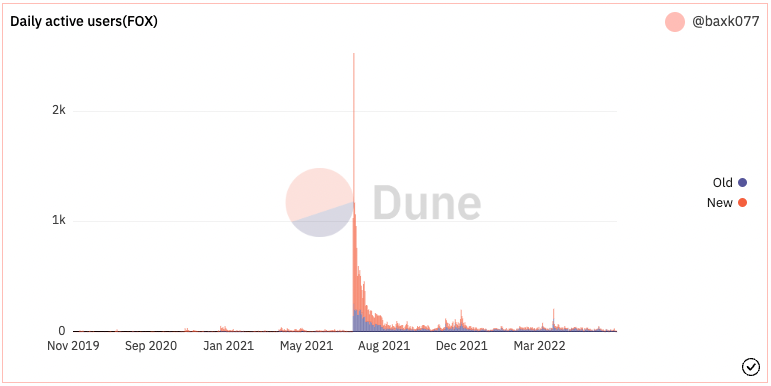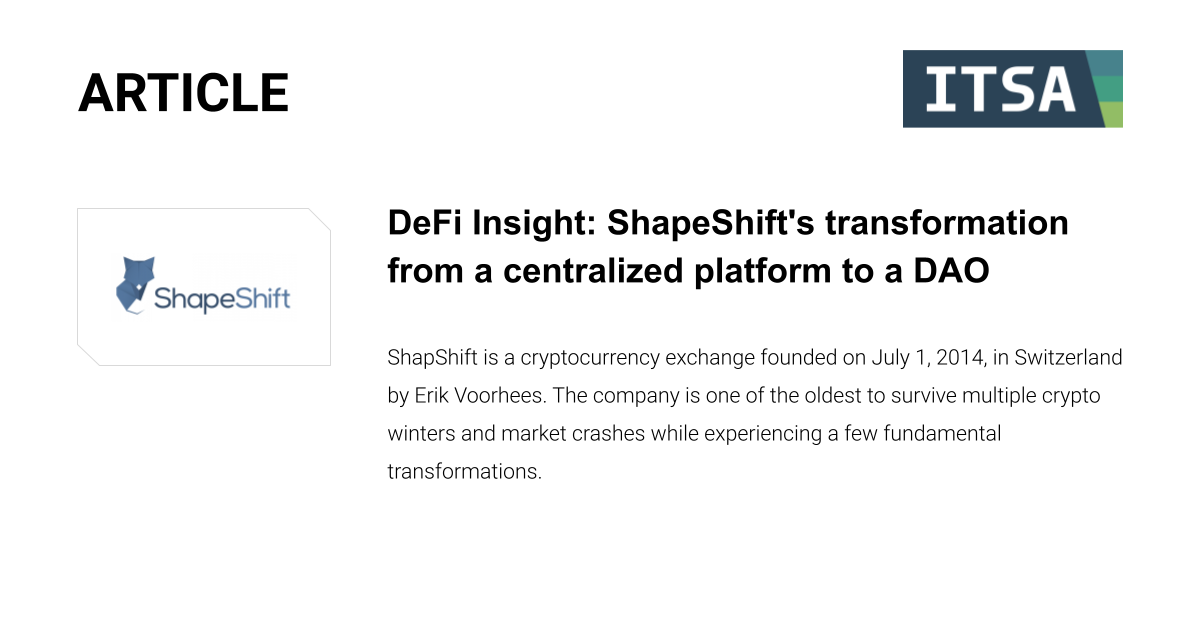Share this
DeFi Insight: ShapeShift’s transformation from a centralized platform to a DAO
by Valentin Kalinov on Jul 8, 2022 12:50:04 PM
ShapeShift is a cryptocurrency exchange founded on July 1, 2014, in Switzerland by Erik Voorhees. The company is one of the oldest to survive multiple crypto winters and market crashes while experiencing a few fundamental transformations. Shapeshift started as a centralized but non-custodial crypto exchange without KYC integration, where anyone could swap their tokens for any cryptocurrency with no questions asked. At that time, the philosophy of ShapeShift was to be open and permissionless to anyone. After the ICO hype cycle in 2018, regulators have pushed for new legislation in the crypto industry, and exchanges like ShapeShift, where users did not even need an account to trade, were forced to shut down or integrate KYC standards. The second version of ShapeShift did exactly that and introduced a new user interface and new KYC measures. It was evident that people were not interested in the new model and preferred the established exchanges for trading and ShapeShift lost many customers. The developments forced the founder Erik Voorhees to rethink the model of the centralized exchange and go back to the old spirit of the project. In 2021, a blog post called “ShapeShift is Decentralizing” announced the company had begun decentralizing. ShapeShift’s entire corporate structure was wound down and the company moved to a DAO structure, becoming a DEX. To facilitate the new structure, the company announced the largest airdrop in history by that time, distributing FOX tokens to over a million customers and hundreds of thousands DeFi community members.
Authors: Valentin Kalinov, Christian Viehof
What led to the decentralization of ShapeShift?
In early 2020 the crypto industry witnessed the rise of DeFi and decentralized exchanges like Uniswap. The interest for these exchanges rose exponentially to the point where Uniswap could sometimes rival Coinbase by trading volume. During this time, ShapeShift decided to decentralize.

In an interview for Coindesk, Erik Voorhees announced the transition from an equity-based VC-backed corporate entity to a DAO with 5% of all FOX tokens owned by the founder. ShapeShift airdropped about one-third of the total supply of FOX (max supply 1B tokens) to a million previous customers and more than 100k community members. The radical shift requires ShapeShift to dissolve all of its legal entities worldwide. Uniswap, for example, operates on the open-source protocol but is also operated by a US company. Shapeshift wants to go one step further and not rely on any legal entity for its existence. People working for the DAO are paid in FOX tokens and there are no employment contracts or working hours.
Technological Setup and the FOX token
ShapeShift partners with 0x (a DEX aggregator that facilitates the peer-to-peer (P2P) exchange of ERC-20 tokens) and cross-chain swapping protocol THORChain to compile over 50 DEXs and around 1,000 trading pairs into one interface. Thanks to THORChain, users can even swap native BTC with ETH. ShapeShift picks the protocol needed to execute the trade depending on the type of trade. Shapeshift aims to become a multi-purpose DeFi tool platform for portfolio tracking and asset management that aggregates protocols and services for trading and yield generation.
FOX is an ERC-20 token created by ShapeShift, which serves as the governance token for the ShapeShift DAO. The total supply of FOX is 1,000,001,337 tokens and it is fixed.


In addition to the voting rights, FOX holders have several opportunities to earn yield from their FOX holdings. FOX can be staked on Bancor (single-sided), users can supply liquidity to a FOX/WETH liquidity pool on the MATIC chain via SushiSwap , supply liquidity to a FOX/RUNE liquidity pool via THORChain and earn RUNE rewards, or stake FOX/HNY in Giveth’s RegenFarm (RegenFarms support the growth of the GIVeconomy: a steady stream of $GIV that flows out to our early supporters continuously until 2026). In addition, lending and borrowing of FOX is enabled on Rari Capital. As the ecosystem grows, FOX holders will have more opportunities for earning yield on their holdings.
FOXy and vFOX
FOXy is an ERC-20 rebasing Token redeemable 1:1 with FOX Tokens that offers a gas-efficient way to earn optimal yield. FOXy is granted to any user who stakes their FOX in the FOXy contract. A user’s FOXy grows in quantity through rebasing.
“The DAO achieves this initially by utilizing the Tokemak reactor, which enables staked FOX to earn TOKE rewards. The DAO will then convert their TOKE rewards from the reactor to FOX, which will be used to reward FOX stakers.”, shapeshift.com
vFOX is a sub-DAO (part of ShapeShift) dedicated to making strategic allocations on behalf of the ShapeShift community. In essence, vFOX is the investment arm of the ShapeShift DAO for emerging crypto projects and vFOX is the token of that protocol.
Foxchain
ShapeShift Corp. currently pays AWS (Amazon Web Services) to host meta-data centrally. FOXChain will be a Cosmos SDK-based blockchain data availability network using Tendermint consensus with the goal of hosting blockchain data in a decentralized manner and will be developed in collaboration with Coinbase Cloud. The idea of Foxchain is to store metadata for every blockchain ShapeShift interacts with. Anyone who needs node data will be able to use Foxchain for their projects. This project is considered the last step in the full decentralization of ShapeShift. The Foxchain will incentivize node operators to host blockchain metadata and take the role of a decentralized back-end infrastructure for the DAO.
The classification of FOX according to the ITC:

Economic Purpose (EEP): FOX is listed as a Settlement and Governance Token (EEP22TU03) since it is part of the DAO governance structure.
Industry Type (EIN): The issuer of FOX is active in the field of Decentralized Exchanges, Markets and Market Making (EIN06DF01).
Technological Setup (TTS): FOX is an Ethereum ERC-20 Standard Token (TTS42ET01). The Class “Ethereum ERC-20 Standard Token” captures every token that is implemented by means of the ERC-20 Standard on top of the Ethereum blockchain.
Legal Clam (LLC): The FOX token does not entitle its holder to any legal claim or rights against the issuing organization; therefore, it is listed as a No-Claim Token (LLC31).
Issuer Type (LIT): The dimension “Issuer Type” provides information on the nature of the issuer of the token. FOX is built by ShapeShift Corp., its Issuer Type is a Private Sector Legal Entity (LIT61PV). However, this category will be a subject of change when ShapeShift becomes fully decentralized.
Regulatory Framework (EU) (REU): The dimension “Regulatory Status EU” provides information on the potential classification of a token according to the European Commission’s proposal for a Regulation on Markets in Crypto Assets (MiCA, Regulation Proposal COM/2020/593 final). The FOX token qualifies as a Utility Token (REU51UT) according to the definition provided in Article 3 (5) of Regulation Proposal COM/2020/593 final.
The International Token Standardization Association (ITSA) e.V.
The International Token Standardization Association (ITSA) e.V. is a not-for-profit association of German law that aims at promoting the development and implementation of comprehensive market standards for the identification, classification, and analysis of DLT- and blockchain-based cryptographic tokens. As an independent industry membership body, ITSA unites over 100 international associated founding members from various interest groups. In order to increase transparency and safety on global token markets, ITSA currently develops and implements the International Token Identification Number (ITIN) as a market standard for the identification of cryptographic tokens, the International Token Classification (ITC) as a standard framework for the classification of cryptographic tokens according to their inherent characteristics. ITSA then adds the identified and classified token to the world’s largest register for tokens in our Tokenbase.
- The International Token Identification Number (ITIN) is a 9-digit alphanumeric technical identifier for both fungible and non-fungible DLT-based tokens. Thanks to its underlying Uniform Token Locator (UTL), ITIN presents a unique and fork-resilient identification of tokens. The ITIN also allows for the connecting and matching of other media and data to the token, such as legal contracts or price data, and increases safety and operational transparency when handling these tokens.
- The International Token Classification (ITC) is a multi-dimensional, expandable framework for the classification of tokens. Current dimensions include technological, economic, legal, and regulatory dimensions with multiple sub-dimensions. By mid-2021, there will be at least two new dimensions added, including a tax dimension. So far, our classification framework has been applied to 99% of the token market according to the market capitalization of classified tokens.
- ITSA’s Tokenbase currently holds data on over 4000 tokens. Tokenbase is a holistic database for the analysis of tokens and combines our identification and classification data with market and blockchain data from external providers. Third-party data of several partners is already integrated, and API access is also in development.
Remarks
If you like this article, we would be happy if you forward it to your colleagues or share it on social networks. More information about the International Token Standardization Association can be found on the Internet, on Twitter, or on LinkedIn.
Valentin Kalinov is an Executive Director at International Token Standardization Association (ITSA) e.V., working to create the world’s largest token database, including a classification framework and unique token identifiers and locators. He has over five years of experience working at BlockchainHub Berlin in content creation and token analysis, as a project manager at the Research Institute for Cryptoeconomics at the Vienna University of Economics and token analyst at Token Kitchen. You can contact Valentin via valentin.kalinov@itsa.global and connect on Linkedin if you would like to further discuss ITSA e.V. or have any other open questions.
Christian Viehof is an Executive Director at the International Token Standardization Association (ITSA) e.V., working to create the world’s largest token database including a classification framework and unique token identifiers and locators. He completed his Bachelor in Economics at the University of Bonn, the Hong Kong University and the London School of Economics and Political Science with a focus on Behavioral Economics and Finance. Currently pursuing his Master of Finance at the Frankfurt School of Finance and Management, you can contact him via christian.viehof@itsa.global and connect with him on Linkedin, if you would like to further discuss ITSA e.V. or have any open questions.


